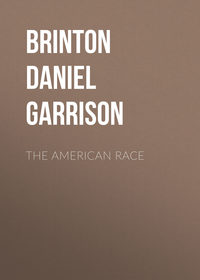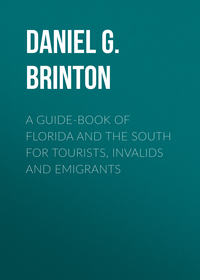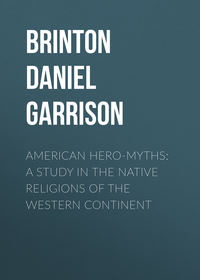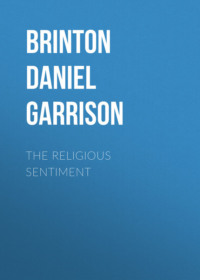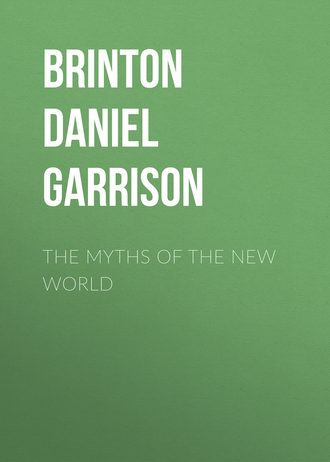 полная версия
полная версияThe Myths of the New World
The tender and hallowed associations that have so widely shielded the dove from harm, which for instance Xenophon mentions among the ancient Persians, were not altogether unknown to the tribes of the New World. Neither the Hurons nor Mandans would kill them, for they believed they were inhabited by the souls of the departed,136 and it is said, but on less satisfactory authority, that they enjoyed similar immunity among the Mexicans. Their soft and plaintive note and sober russet hue widely enlisted the sympathy of man, and linked them with his more tender feelings.
“As wise as the serpent, as harmless as the dove,” is an antithesis that might pass current in any human language. They are the emblems of complementary, often contrasted qualities. Of all animals, the serpent is the most mysterious. No wonder it possessed the fancy of the observant child of nature. Alone of creatures it swiftly progresses without feet, fins, or wings. “There be three things which are too wonderful for me, yea, four which I know not,” said wise King Solomon; and the chief of them were, “the way of an eagle in the air, the way of a serpent upon a rock.”
Its sinuous course is like to nothing so much as that of a winding river, which therefore we often call serpentine. So did the Indians. Kennebec, a stream in Maine, in the Algonkin means snake, and Antietam, the creek in Maryland of tragic celebrity, in an Iroquois dialect has the same significance. How easily would savages, construing the figure literally, make the serpent a river or water god! Many species being amphibious would confirm the idea. A lake watered by innumerable tortuous rills wriggling into it, is well calculated for the fabled abode of the king of the snakes. Thus doubtless it happened that both Algonkins and Iroquois had a myth that in the great lakes dwelt a monster serpent, of irascible temper, who unless appeased by meet offerings raised a tempest or broke the ice beneath the feet of those venturing on his domain, and swallowed them down.137
The rattlesnake was the species almost exclusively honored by the red race. It is slow to attack, but venomous in the extreme, and possesses the power of the basilisk to attract within reach of its spring small birds and squirrels. Probably this much talked of fascination is nothing more than by its presence near their nests to incite them to attack, and to hazard near and nearer approaches to their enemy in hope to force him to retreat, until once within the compass of his fell swoop they fall victims to their temerity. I have often watched a cat act thus. Whatever explanation may be received, the fact cannot be questioned, and is ever attributed by the unreflecting, to some diabolic spell cast upon them by the animal. They have the same strange susceptibility to the influence of certain sounds as the vipers, in which lies the secret of snake charming. Most of the Indian magicians were familiar with this singularity. They employed it with telling effect to put beyond question their intercourse with the unseen powers, and to vindicate the potency of their own guardian spirits who thus enabled them to handle with impunity the most venomous of reptiles.138 The well-known antipathy of these serpents to certain plants, for instance the hazel, which bound around the ankles is an efficient protection against their attacks, and perhaps some antidote to their poison used by the magicians, led to their frequent introduction in religious ceremonies. Such exhibitions must have made a profound impression on the spectators, and redounded in a corresponding degree to the glory of the performer. “Who is a manito?” asks the mystic meda chant of the Algonkins. “He,” is the reply, “he who walketh with a serpent, walking on the ground, he is a manito.”139 And the intimate alliance of this symbol with the most sacred mysteries of religion, the darkest riddles of the Unknown, is reflected in their language, and also in that of their neighbors the Dakotas, in both of which the same words manito, wakan, which express divinity in its broadest sense, are also used as generic terms signifying this species of animals! This strange fact is not without a parallel, for in both Arabic and Hebrew, the word for serpent has many derivatives, meaning to have intercourse with demoniac powers, to practise magic, and to consult familiar spirits.140
The pious founder of the Moravian brotherhood, the Count of Zinzendorf, owed his life on one occasion to this deeply rooted superstition. He was visiting a missionary station among the Shawnees, in the Wyoming valley. Recent quarrels with the whites had unusually irritated this unruly folk, and they resolved to make him their first victim. After he had retired to his secluded hut, several of their braves crept upon him, and cautiously lifting the corner of the lodge, peered in. The venerable man was seated before a little fire, a volume of the Scriptures on his knees, lost in the perusal of the sacred words. While they gazed, a huge rattlesnake, unnoticed by him, trailed across his feet, and rolled itself into a coil in the comfortable warmth of the fire. Immediately the would-be murderers forsook their purpose and noiselessly retired, convinced that this was indeed a man of God.
A more unique trait than any of these is its habit of casting its skin every spring, thus as it were renewing its life. In temperate latitudes the rattlesnake, like the leaves and flowers, retires from sight during the cold season, and at the return of kindly warmth puts on a new and brilliant coat. Its cast-off skin was carefully collected by the savages and stored in the medicine bag as possessing remedial powers of high excellence. Itself thus immortal, they thought it could impart its vitality to them. So when the mother was travailing in sore pain, and the danger neared that the child would be born silent, the attending women hastened to catch some serpent and give her its blood to drink.141
It is well known that in ancient art this animal was the symbol of Æsculapius, and to this day, Professor Agassiz found that the Maues Indians, who live between the upper Tapajos and Madeira Rivers in Brazil, whenever they assign a form to any “remedio,” give it that of a serpent.142
Probably this notion that it was annually rejuvenated led to its adoption as a symbol of Time among the Aztecs; or, perchance, as they reckoned by suns, and the figure of the sun, a circle, corresponds to nothing animate but a serpent with its tail in its mouth, eating itself, as it were, this may have been its origin. Either of them is more likely than that the symbol arose from the recondite reflection that time is “never ending, still beginning, still creating, still destroying,” as has been suggested.
Only, however, within the last few years has the significance of the serpent symbol in its length and breadth been satisfactorily explained, and its frequent recurrence accounted for. By a searching analysis of Greek and German mythology, Dr. Schwarz, of Berlin, has shown that the meaning which is paramount to all others in this emblem is the lightning; a meaning drawn from the close analogy which the serpent in its motion, its quick spring, and mortal bite, has to the zigzag course, the rapid flash, and sudden stroke of the electric discharge. He even goes so far as to imagine that by this resemblance the serpent first acquired the veneration of men. But this is an extravagance not supported by more thorough research. He has further shown with great aptness of illustration how, by its dread effects, the lightning, the heavenly serpent, became the god of terror and the opponent of such heroes as Beowulf, St. George, Thor, Perseus, and others, mythical representations of the fearful war of the elements in the thunder storm; how from its connection with the advancing summer and fertilizing showers it bore the opposite character of the deity of fruitfulness, riches, and plenty; how, as occasionally kindling the woods where it strikes, it was associated with the myths of the descent of fire from heaven, and as in popular imagination where it falls it scatters the thunderbolts in all directions, the flint-stones which flash when struck were supposed to be these fragments, and gave rise to the stone worship so frequent in the old world; and how, finally, the prevalent myth of a king of serpents crowned with a glittering stone or wearing a horn is but another type of the lightning.143 Without accepting unreservedly all these conclusions, I shall show how correct they are in the main when applied to the myths of the New World, and thereby illustrate how the red race is of one blood and one faith with our own remote ancestors in heathen Europe and Central Asia.
It asks no elaborate effort of the imagination to liken the lightning to a serpent. It does not require any remarkable acuteness to guess the conundrum of Schiller:—
“Unter allen Schlangen ist eineAuf Erden nicht gezeugt,Mit der an Schnelle keine,An Wuth sich keine vergleicht.”When Father Buteux was a missionary among the Algonkins, in 1637, he asked them their opinion of the nature of lightning. “It is an immense serpent,” they replied, “which the Manito is vomiting forth; you can see the twists and folds that he leaves on the trees which he strikes; and underneath such trees we have often found huge snakes.” “Here is a novel philosophy for you!” exclaims the Father.144 So the Shawnees called the thunder “the hissing of the great snake;”145 and Tlaloc, the Toltec thunder god, held in his hand a serpent of gold to represent the lightning.146 For this reason the Caribs spoke of the god of the thunder storm as a great serpent dwelling in the fruit forests,147 and in the Quiché legends other names for Hurakan, the hurricane or thunder-storm, are the Strong Serpent, He who hurls below, referring to the lightning.148
Among the Hurons, in 1648, the Jesuits found a legend current that there existed somewhere a monster serpent called Onniont, who wore on his head a horn that pierced rocks, trees, hills, in short everything he encountered. Whoever could get a piece of this horn was a fortunate man, for it was a sovereign charm and bringer of good luck. The Hurons confessed that none of them had had the good hap to find the monster and break his horn, nor indeed had they any idea of his whereabouts; but their neighbors, the Algonkins, furnished them at times small fragments for a large consideration.149 Clearly the myth had been taught them for venal purposes by their trafficking visitors. Now among the Algonkins, the Shawnee tribe did more than all others combined to introduce and carry about religious legends and ceremonies. From the earliest times they seem to have had peculiar aptitude for the ecstasies, deceits, and fancies that made up the spiritual life of their associates. Their constantly roving life brought them in contact with the myths of many nations. And it is extremely probable that they first brought the tale of the horned serpent from the Creeks and Cherokees. It figured extensively in the legends of both these tribes.
The latter related that once upon a time among the glens of their mountains dwelt the prince of rattlesnakes. Obedient subjects guarded his palace, and on his head glittered in place of a crown a gem of marvellous magic virtues. Many warriors and magicians tried to get possession of this precious talisman, but were destroyed by the poisoned fangs of its defenders. Finally, one more inventive than the rest hit upon the bright idea of encasing himself in leather, and by this device marched unharmed through the hissing and snapping court, tore off the shining jewel, and bore it in triumph to his nation. They preserved it with religious care, brought it forth on state occasions with solemn ceremony, and about the middle of the last century, when Captain Timberlake penetrated to their towns, told him its origin.150
The charm which the Creeks presented their young men when they set out on the war path was of very similar character. It was composed of the bones of the panther and the horn of the fabulous horned snake. According to a legend taken down by an unimpeachable authority toward the close of the last century, the great snake dwelt in the waters; the old people went to the brink and sang the sacred songs. The monster rose to the surface. The sages recommenced the mystic chants. He rose a little out o the water. Again they repeated the songs. This time he showed his horns and they cut one off. Still a fourth time did they sing, and as he rose to listen cut off the remaining horn. A fragment of these in the “war physic” protected from inimical arrows and gave success in the conflict.151
In these myths, which attribute good fortune to the horn of the snake, that horn which pierces trees and rocks, which rises from the waters, which glitters as a gem, which descends from the ravines of the mountains, we shall not overstep the bounds of prudent reasoning if we see the thunderbolt, sign of the fructifying rain, symbol of the strength of the lightning, horn of the heavenly serpent. They are strictly meteorological in their meaning. And when in later Algonkin tradition the hero Michabo appears in conflict with the shining prince of serpents who lives in the lake and floods the earth with its waters, and destroys the reptile with a dart, and further when the conqueror clothes himself with the skin of his foe and drives the rest of the serpents to the south where in that latitude the lightnings are last seen in the autumn;152 or when in the traditional history of the Iroquois we hear of another great horned serpent rising out of the lake and preying upon the people until a similar hero-god destroys it with a thunderbolt,153 we cannot be wrong in rejecting any historical or ethical interpretation, and in construing them as allegories which at first represented the atmospheric changes which accompany the advancing seasons and the ripening harvests. They are narratives conveying under agreeable personifications the tidings of that unending combat which the Dakotas said was being waged with varying fortunes by Unktahe against Wauhkeon, the God of Waters against the Thunder Bird.154 They are the same stories which in the old world have been elaborated into the struggles of Ormuzd and Ahriman, of Thor and Midgard, of St. George and the Dragon, and a thousand others.
Yet it were but a narrow theory of natural religion that allowed no other meaning to these myths. Many another elemental warfare is being waged around us, and applications as various as nature herself lie in these primitive creations of the human fancy. Let it only be remembered that there was never any moral, never any historical purport in them in the infancy of religious life.
In snake charming as a proof of proficiency in magic, and in the symbol of the lightning, which brings both fire and water, which in its might controls victory in war, and in its frequency, plenteous crops at home, lies the secret of the serpent symbol. As the “war physic” among the tribes of the United States was a fragment of a serpent, and as thus signifying his incomparable skill in war, the Iroquois represent their mythical king Atatarho clothed in nothing but black snakes; so that when he wished to don a new suit he simply drove away one set and ordered another to take their places,155 so, by a precisely similar mental process, the myth of the Nahuas assigns as a mother to their war god Huitzilapochtli, Coatlicue, the robe of serpents; her dwelling place Coatepec, the hill of serpents; and at her lying-in say that she brought forth a serpent. Her son’s image was surrounded by serpents, his sceptre was in the shape of one, his great drum was of serpents’ skins, and his statue rested on four vermiform caryatides.
As the symbol of the fertilizing summer showers the lightning serpent was the god of fruitfulness. Born in the atmospheric waters, it was an appropriate attribute of the ruler of the winds. But we have already seen that the winds were often spoken of as great birds. Hence the union of these two emblems in such names as Quetzalcoatl, Gucumatz, Kukulkan, all titles of the god of the air in the languages of Central America, all signifying the “Bird-serpent.” Here also we see the solution of that monument which has so puzzled American antiquaries, the cross at Palenque. It is a tablet on the wall of an altar representing a cross surmounted by a bird and supported by the head of a serpent. The latter is not well defined in the plate in Mr. Stephens’ Travels, but is very distinct in the photographs taken by M. Charnay, which that gentleman was kind enough to show me. The cross I have previously shown was the symbol of the four winds, and the bird and serpent are simply the rebus of the air god, their ruler.156 Quetzalcoatl, called also Yolcuat, the rattlesnake, was no less intimately associated with serpents than with birds. The entrance to his temple at Mexico represented the jaws of one of these reptiles, and he finally disappeared in the province of Coatzacoalco, the hiding place of the serpent, sailing towards the east in a bark of serpents’ skins. All this refers to his power over the lightning serpent.
He was also said to be the god of riches and the patron consequently of merchants. For with the summer lightning come the harvest and the ripening fruits, come riches and traffic. Moreover “the golden color of the liquid fire,” as Lucretius expresses it, naturally led where this metal was known, to its being deemed the product of the lightning. Thus originated many of those tales of a dragon who watches a treasure in the earth, and of a serpent who is the dispenser of riches, such as were found among the Greeks and ancient Germans.157 So it was in Peru where the god of riches was worshipped under the image of a rattlesnake horned and hairy, with a tail of gold. It was said to have descended from the heavens in the sight of all the people, and to have been seen by the whole army of the Inca.158 Whether it was in reference to it, or as emblems of their prowess, that the Incas themselves chose as their arms two serpents with their tails interlaced, is uncertain; possibly one for each of these significations.
Because the rattlesnake, the lightning serpent, is thus connected with the food of man, and itself seems never to die but annually to renew its youth, the Algonkins called it “grandfather” and “king of snakes;” they feared to injure it; they believed it could grant prosperous breezes, or raise disastrous tempests; crowned with the lunar crescent it was the constant symbol of life in their picture writing; and in the meda signs the mythical grandmother of mankind me suk kum me go kwa was indifferently represented by an old woman or a serpent.159 For like reasons Cihuacoatl, the Serpent Woman, in the myths of the Nahuas was also called Tonantzin, our mother.160
The serpent symbol in America has, however, been brought into undue prominence. It had such an ominous significance in Christian art, and one which chimed so well with the favorite proverb of the early missionaries—“the gods of the heathens are devils”—that wherever they saw a carving or picture of a serpent they at once recognized the sign manual of the Prince of Darkness, and inscribed the fact in their note-books as proof positive of their cherished theory. After going over the whole ground, I am convinced that none of the tribes of the red race attached to this symbol any ethical significance whatever, and that as employed to express atmospheric phenomena, and the recognition of divinity in natural occurrences, it far more frequently typified what was favorable and agreeable than the reverse.
CHAPTER V.
THE MYTHS OF WATER, FIRE, AND THE THUNDER-STORM
Water the oldest element.—Its use in purification.—Holy water.—The Rite of Baptism.—The Water of Life.—Its symbols.—The Vase.—The Moon.—The latter the goddess of love and agriculture, but also of sickness, night, and pain.—Often represented by a dog.—Fire worship under the form of Sun worship.—The perpetual fire.—The new fire—Burning the dead.—A worship of the passions, but no sexual dualism in myths, nor any phallic worship in America.—Synthesis of the worship of Fire, Water, and the Winds in the Thunder-storm, personified as Haokah, Tupa, Catequil, Contici, Heno, Tlaloc, Mixcoatl, and other deities, many of them triune.
THE primitive man was a brute in everything but the susceptibility to culture; the chief market of his time was to sleep, fight, and feed; his bodily comfort alone had any importance in his eyes; and his gods were nothing, unless they touched him here. Cold, hunger, thirst, these were the hounds that were ever on his track; these were the fell powers he saw constantly snatching away his fellows, constantly aiming their invisible shafts at himself. Fire, food, and water were the gods that fought on his side; they were the chief figures in his pantheon, his kindliest, perhaps his earliest, divinities.
With a nearly unanimous voice mythologies assign the priority to water. It was the first of all things, the parent of all things. Even the gods themselves were born of water, said the Greeks and the Aztecs. Cosmogonies reach no further than the primeval ocean that rolled its shoreless waves through a timeless night.
“Omnia pontus erant, deerant quoque litora ponto.”Earth, sun, stars, lay concealed in its fathomless abysses. “All of us,” ran the Mexican baptismal formula, “are children of Chalchihuitlycue, Goddess of Water,” and the like was said by the Peruvians of Mama Cocha, by the Botocudos of Taru, by the natives of Darien of Dobayba, by the Iroquois of Ataensic—all of them mothers of mankind, all personifications of water.
How account for such unanimity? Not by supposing some ancient intercourse between remote tribes, but by the uses of water as the originator and supporter, the essential prerequisite of life. Leaving aside the analogy presented by the motherly waters which nourish the unborn child, nor emphasizing how indispensable it is as a beverage, the many offices this element performs in nature lead easily to the supposition that it must have preceded all else. By quenching thirst, it quickens life; as the dew and the rain it feeds the plant, and when withheld the seed perishes in the ground and forests and flowers alike wither away; as the fountain, the river, and the lake, it enriches the valley, offers safe retreats, and provides store of fishes; as the ocean, it presents the most fitting type of the infinite. It cleanses, it purifies; it produces, it preserves. “Bodies, unless dissolved, cannot act,” is a maxim of the earliest chemistry. Very plausibly, therefore, was it assumed as the source of all things.
The adoration of streams, springs, and lakes, or rather of the spirits their rulers, prevailed everywhere; sometimes avowedly because they provided food, as was the case with the Moxos, who called themselves children of the lake or river on which their village was, and were afraid to migrate lest their parent should be vexed;161 sometimes because they were the means of irrigation, as in Peru, or on more general mythical grounds. A grove by a fountain is in all nature worship the ready-made shrine of the sylphs who live in its limpid waves and chatter mysteriously in its shallows. On such a spot in our Gulf States one rarely fails to find the sacrificial mound of the ancient inhabitants, and on such the natives of Central America were wont to erect their altars (Ximenes). Lakes are the natural centres of civilization. Like the lacustrine villages which the Swiss erected in ante-historic times, like ancient Venice, the city of Mexico was first built on piles in a lake, and for the same reason—protection from attack. Security once obtained, growth and power followed. Thus we can trace the earliest rays of Aztec civilization rising from lake Tezcuco, of the Peruvian from Lake Titicaca, of the Muyscas from Lake Guatavita. These are the centres of legendary cycles. Their waters were hallowed by venerable reminiscences. From the depths of Titicaca rose Viracocha, mythical civilizer of Peru. Guatavita was the bourne of many a foot-sore pilgrim in the ancient empire of the Zac. Once a year the high priest poured the collective offerings of the multitude into its waves, and anointed with oils and glittering with gold dust, dived deep in its midst, professing to hold communion with the goddess who there had her home.162
Not only does the life of man but his well-being depends on water. As an ablution it invigorates him bodily and mentally. No institution was in higher honor among the North American Indians than the sweat-bath followed by the cold douche. It was popular not only as a remedy in every and any disease, but as a preliminary to a council or an important transaction. Its real value in cold climates is proven by the sustained fondness for the Russian bath in the north of Europe. The Indians, however, with their usual superstition attributed its good effects to some mysterious healing power in water itself. Therefore, when the patient was not able to undergo the usual process, or when his medical attendant was above the vulgar and routine practice of his profession, it was administered on the infinitesimal system. The quack muttered a formula over a gourd filled from a neighboring spring and sprinkled it on his patient, or washed the diseased part, or sucked out the evil spirit and blew it into a bowl of water, and then scattered the liquid on the fire or earth.163


